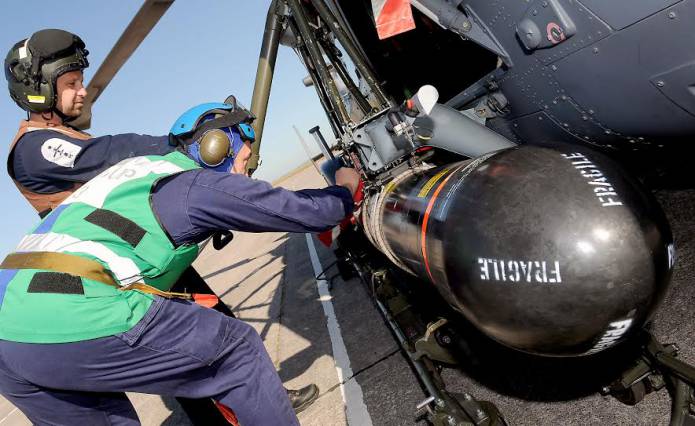YEOVILTON LIFE: Sting Ray away for the Wildcat

THE Royal Navy’s principal weapon in the fight against submarines – the Wildcat of 825 Naval Air Squadron based at RNAS Yeovilton – has been practising torpedo attacks off the Cornish coast.
A Wildcat spent two days over Falmouth Bay and culminated in the launch of a dummy weapon.
In various forms, Sting Ray has been in service with the Royal Navy for more than 30 years. It is carried by frigates - thrust out of launchers by a high-pressure air - and Fleet Air Arm Merlin’s who carry four, with Lynx helicopters armed with two. The Royal Navy’s submarines kill their underwater prey with the much heavier Spearfish torpedo.
The Lynx’s successor Wildcat is beginning to enter front-line service – the first is currently on deployment with HMS Lancaster in the Atlantic – and although it has undergone extensive trials and testing over the past five years, until now it has not dropped a torpedo.
That was put right on the range off the Lizard Peninsula – brought back into use by RNAS Culdrose for torpedo tests only last year after a 15-year pause.
Normally, Sting Ray is packed with a 100lb explosive charge, racing through the water at speeds in excess of 50mph. For the dummy runs and firing off Falmouth, a TVT (Training Variant Torpedo – 100lb of concrete replaces the high explosive) was loaded aboard Wildcat ZZ378 at RNAS Culdrose in nearby Helston.
As with a live Sting Ray, a drogue parachute slows the weapon’s entry into the water but the torpedo is set to float when it has completed its run and is then recovered.
Lt Frank Suter, the Wildcat observer and aviation warfare officer conducting the trials, said: “This marks another milestone in the introduction into Service for the Wildcat HMA Mk2 and proves our ability to contribute to the UK and Royal Navy’s Anti Submarine Warfare capability.”
Tags:
News.
Recent Posts
 YEOVIL NEWS: Police appeal for witnesses after man threatened and forced into a vehicle
YEOVIL NEWS: Police appeal for witnesses after man threatened and forced into a vehicle YEOVIL NEWS: Alan’s poetry goes into print – at the age of 86
YEOVIL NEWS: Alan’s poetry goes into print – at the age of 86 YEOVIL NEWS: Police reassure public after armed officers arrest man in Yeovil
YEOVIL NEWS: Police reassure public after armed officers arrest man in Yeovil YEOVIL NEWS: Yeovil Celebrates free event planned to take place again in 2024
YEOVIL NEWS: Yeovil Celebrates free event planned to take place again in 2024 YEOVIL NEWS: Wonderful Wiek’s still going strong at 80 and 60 years as Dale Fender
YEOVIL NEWS: Wonderful Wiek’s still going strong at 80 and 60 years as Dale Fender YEOVIL NEWS: Breast cancer unit appeal hits £2.4m – thanks to ladies that lunch!
YEOVIL NEWS: Breast cancer unit appeal hits £2.4m – thanks to ladies that lunch! YEOVIL NEWS: Vicar says he hopes defibrillator never has to be used for an emergency
YEOVIL NEWS: Vicar says he hopes defibrillator never has to be used for an emergency YEOVIL NEWS: Growing Pains brought dance alive and left me transfixed by its creativity
YEOVIL NEWS: Growing Pains brought dance alive and left me transfixed by its creativity YEOVIL NEWS: A good teacher is like a candle and Ken Davy illuminated the classroom
YEOVIL NEWS: A good teacher is like a candle and Ken Davy illuminated the classroom YEOVIL AREA NEWS: Chinnock Hollow to remain closed to traffic after £2.7million repair price tag
YEOVIL AREA NEWS: Chinnock Hollow to remain closed to traffic after £2.7million repair price tag YEOVIL AREA NEWS: Man exposes himself at Ham Hill
YEOVIL AREA NEWS: Man exposes himself at Ham Hill YEOVIL NEWS: The panto is such good fun we had to go and watch for a second time!
YEOVIL NEWS: The panto is such good fun we had to go and watch for a second time! YEOVIL NEWS: Evolution never fails to disappoint with panto magic at the Octagon
YEOVIL NEWS: Evolution never fails to disappoint with panto magic at the Octagon RIP QUEEN ELIZABETH II: Public invited to lay floral tributes at St John’s churchyard in Yeovil
RIP QUEEN ELIZABETH II: Public invited to lay floral tributes at St John’s churchyard in Yeovil RIP Queen Elizabeth II – who served the UK and Commonwealth with such distinction
RIP Queen Elizabeth II – who served the UK and Commonwealth with such distinction

















